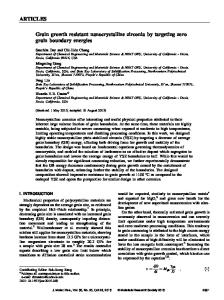Incontinuous grain growth in pure Co nanocrystalline powders prepared by mechanical attrition
- PDF / 1,525,369 Bytes
- 7 Pages / 612 x 792 pts (letter) Page_size
- 59 Downloads / 276 Views
Highly pure Co nanocrystalline powders were prepared by high-energy ball milling under the condition that all operations on the powders were performed in the glovebox filled with highly purified argon gas. A series of annealing experiments at different temperatures were carried out to investigate grain growth in the milled powders. The as-milled and annealed microstructures were observed and analyzed with transmission electron microscopy (TEM), high-resolution TEM, high-resolution scanning electron microscopy, and x-ray diffraction methods. Characteristics of the incontinuous grain growth in the milled nanocrystalline powders were found. It is considered by the authors that the sharp increase in nanograin size in certain intermediate-temperature region is a result of accelerated grain growth promoted by the stored energy as a supplied driving force, and through a particular dominant mechanism of nanograin rotations in contrast to grain boundary migration in polycrystalline materials.
I. INTRODUCTION
In recent years, among several methods that produce nanocrystalline materials, mechanical attrition by ball milling has been more widely used especially in laboratory research owing to its simplicity, low cost and broad applicability to various classes of materials.1,2 To further produce the bulk nanomaterials, the milled nanocrystalline powders have to be consolidated generally at certain high temperatures. Due to the fact that some new or superior properties of nanocrystalline materials may lose when the grain size increases from the nanometer to submicron- or micrometer range, the thermal stability and grain growth behavior of nanocrystalline materials are of special scientific and technological significance. So far, a number of theoretical and experimental researches on grain growth in nanocrystalline materials have been conducted.1–4 However, the proposed mechanisms for nanograin growth are not consistent in the literature.3,4 Concerning the grain growth in nanocrystalline powders produced by mechanical attrition, a large majority of studies focused on the inhibiting effects of impurities and/or the second phase particles further formed on the migration of nanograin boundaries, since for mechanical attrition, there are more possibilities of introducing impurities such as iron, carbon (both mainly from the steel balls), oxygen, and nitrogen into the milled
a)
Address all correspondence to this author. e-mail: [email protected] DOI: 10.1557/JMR.2005.0378
powders than other methods. As a representative, Malow and Koch5 investigated systematically the temperatureand time-dependence of grain growth in nanocrystalline Fe powders produced by high-energy ball milling. They found that the grain growth behavior at lower temperatures or shorter times is different from that at higher temperatures or longer times, the transition between the two stages, as was proposed, is dominated by the segregation of the substitutional impurities to the grain boundaries. As a very important characteristic factor of mechanical attrition,
Data Loading...











